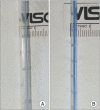Can We Prevent a Postoperative Spinal Epidural Hematoma by Using Larger Diameter Suction Drains?
- PMID: 26929803
- PMCID: PMC4761605
- DOI: 10.4055/cios.2016.8.1.78
Can We Prevent a Postoperative Spinal Epidural Hematoma by Using Larger Diameter Suction Drains?
Abstract
Background: Epidural hematoma is a rare but serious complication. According to previous studies, it is not prevented by suction drains. This study evaluated the following alternative hypothesis: the larger the diameter of a suction drain, the less the remaining epidural hematoma after spinal surgery.
Methods: This was a randomized prospective study. Patients who underwent posterior lumbar decompression and instrumented fusion were divided into two groups: the large drain (LD, 2.8-mm-diameter tube) and small drain (SD, 1.6-mm-diameter tube) groups according to the diameter of the suction drains. All patients were consecutive and allocated alternately according to the date of operations. Suction drains were removed on day 3 and magnetic resonance imaging was performed on day 7 postoperatively. The size of remaining hematomas was measured by the degree of thecal sac compression in cross section using the following 4-point numeric scale: G1, less than one quarter; G2, between one quarter and half; G3, more than half; and G4, more than subtotal obstruction.
Results: There were 39 patients with LDs and 38 with SDs. They did not differ significantly in terms of sex, number of fusion segments, revision or not, antiplatelet medication, intraoperative injection of tranexamic acid. However, patient age differed significantly between the two groups (LD, 63.3 years and < SD, 68.6 years; p = 0.007). The two groups did not differ significantly in terms of prothrombin time, activated partial thromboplastin time, platelet number, blood loss, or operation duration. However, platelet function analysis exhibited a significant difference (LD, 164.7 seconds and < SD, 222.3 seconds; p = 0.002). The two blinded readers showed high consistency (Kappa value = 0.740; p = 0.000). The results of reader 1 were as follows: LD and SD had 21 and 21 cases of G1, 9 and 11 cases of G2, 6 and 6 cases of G3, and 3 and 0 cases of G4, respectively. The results of reader 2 were as follows: LD and SD had 22 and 23 cases of G1, 7 and 9 cases of G2, 7 and 6 cases of G3, and 3 and 0 cases of G4, respectively. There was no difference between the two groups (reader 1, p = 0.636; reader 2, p = 0.466).
Conclusions: The alternative hypothesis was rejected. Therefore, postoperative spinal epidural hematoma would not be prevented by LD.
Keywords: Epidural; Hematoma; Larger suction drain; Postoperative; Spinal.
Conflict of interest statement
Figures


References
-
- Awad JN, Kebaish KM, Donigan J, Cohen DB, Kostuik JP. Analysis of the risk factors for the development of postoperative spinal epidural haematoma. J Bone Joint Surg Br. 2005;87(9):1248–1252. - PubMed
-
- Kou J, Fischgrund J, Biddinger A, Herkowitz H. Risk factors for spinal epidural hematoma after spinal surgery. Spine (Phila Pa 1976) 2002;27(15):1670–1673. - PubMed
-
- Lawton MT, Porter RW, Heiserman JE, Jacobowitz R, Sonntag VK, Dickman CA. Surgical management of spinal epidural hematoma: relationship between surgical timing and neurological outcome. J Neurosurg. 1995;83(1):1–7. - PubMed
-
- Kebaish KM, Awad JN. Spinal epidural hematoma causing acute cauda equina syndrome. Neurosurg Focus. 2004;16(6):e1. - PubMed
Publication types
MeSH terms
LinkOut - more resources
Full Text Sources
Other Literature Sources
Medical
Research Materials

